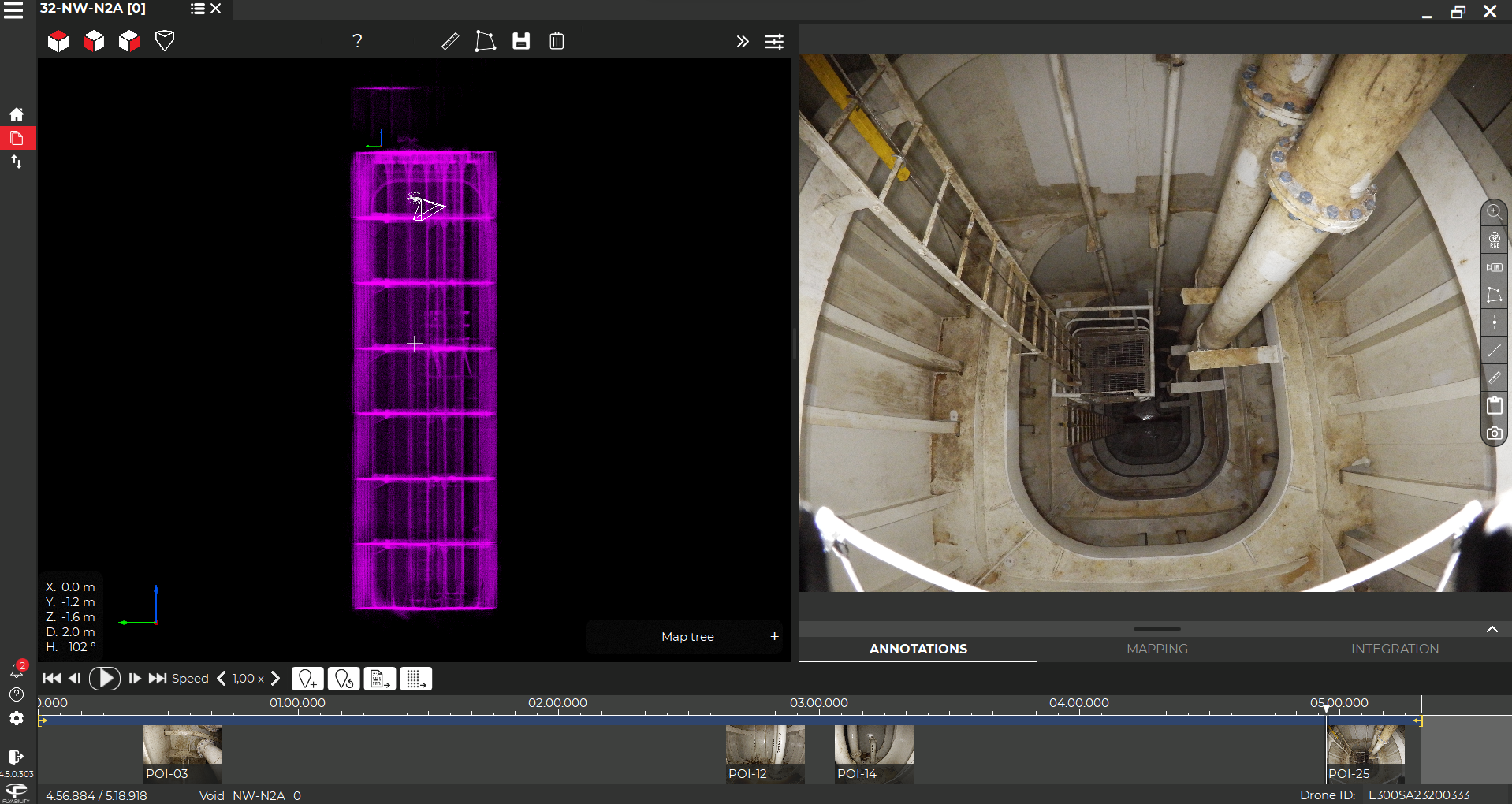TDBR Inspections transformed the game for tank inspections at the 3R-2 rig off the Brazilian coast with the help of Flyability's Elios drones. Speed With just two drones—Elios 2 and Elios 3—and two team members, TDBR Inspections managed to inspect all 63 tanks within two weeks. In the past, this process would have taken months and required a larger team. Safety By deploying drones, there was no need for personnel to enter the tanks or work at heights. This eliminated the need for special permits, streamlining the entire process and reducing risks significantly. Accuracy The results from these inspections were shared with the Class Society, which sets standards for maritime and drilling equipment. All findings from the Elios 2 and Elios 3 matched the stringent class standards. Efficiency Using drones allowed the rig to maintain optimal staffing levels, ensuring that engineers and workers could focus on critical tasks rather than inspections. This improved operational efficiency and resource allocation.   Offshore operations come with unique challenges. Equipment malfunctions or delayed deliveries can lead to costly delays and downtime. Balancing inspection and maintenance needs while maintaining operational efficiency is crucial. This is where innovative solutions like drone inspections come into play. For the 3R-2 rig, a TLWP-type oil rig off the coast of Brazil, conducting major inspections presents a logistical challenge. The rig has a maximum personnel on board (PoB) limit of approximately 60 individuals. These 60 must include engineers, operators, and general staff. Transportation to and from the rig via helicopter adds another layer of complexity, making it essential to optimize PoB numbers and transportation schedules. Inspection of tall tanks poses significant challenges due to their height and confined spaces. However, inspecting assets like tanks onboard can be challenging. The 3R2 features several large tanks, and manual inspections require multiple staff members using ropes, taking several days per tank. Given that the rig is 10 years old and subject to strict regulatory standards, inspections must be thorough to update existing records. The question remains: Can inspections be completed efficiently without deploying large teams of inspectors for extended periods? Striking the right balance can optimize PoB and streamline inspections and data management. TDBR Inspections, a leading drone service provider in Brazil, has extensive experience conducting complex inspections using the Elios drone. They were approached by Raul Martini, a naval engineer from 3R Petroleum, the owner of the 3R-2 rig. The goal was to use the Elios drone for tank inspections and assess whether this approach could save time and resources at the rig. The primary objective was to collect visual data on the condition of the large tanks. TDBR Inspections aimed to build an image archive that could be used for visual inspections, defect detection, and fault identification. Specific areas of interest would then be marked with special paint to highlight sections requiring maintenance. The project was massive, involving over 70 tanks at the site. TDBR Inspections planned to visit 3R-2 four times to gather comprehensive data. The key advantage of using the Elios drone lay in the time and cost savings, along with simplified logistics. Entering a tank of this nature typically requires a special permit, but drones eliminate this requirement. Additionally, the results were intended to be submitted to the Class Society to verify their accuracy. If successful, this initiative could pave the way for a long-term partnership between TDBR Inspections and 3R Petroleum to regularly conduct inspections on the 3R-2 using the Elios drone. A team from TDBR Inspections traveled to the 3R-2 rig to plan their drone flights. This marked Phase 1 of the project. They conducted reconnaissance flights with an Elios 2 to scout the tanks and prepare for asset entry. Inside a ballast tank visualized with the Elios 3.  Following initial external inspection flights during Phase 1, the TDBR Inspections team returned a month later to commence Phase 2. During that time, they purchased an Elios 3 and brought both drones to the 3R-2 rig. Over the span of 14 days, TDBR Inspections’ pilots conducted 88 separate flights in and around 63 tanks. These flights totaled over 10 hours of airtime, utilizing both the Elios 2 and Elios 3. After completing the flights, the data was processed in Inspector 4. Visual inspections from both drones were used to update existing records and identify anomalies, while the Elios 3’s LiDAR data created 3D models of the tank interiors. These models provided clear insights into the tanks' conditions and enabled detailed asset knowledge without anyone entering confined spaces. The scale of this project is unprecedented—inspecting 63 tanks in just two weeks translates to over 10 assets per day. By comparison, traditional methods require up to 4 or 5 rope access technicians and can take up to a week per tank. With an Elios 3, only two people were needed to inspect each tank in just two days. Looking ahead, TDBR Inspections anticipates repeating inspections of this nature at 3R-2 and other similar sites. Their operational efficiency brought significant time and cost savings to the 3R-2 rig’s management, optimizing staff movement and addressing the PoB challenge. Not only did the Elios drones ensure safety by keeping personnel out of confined spaces, but they also gathered data that met the stringent requirements of the Class Society, addressing a pressing industry-wide issue. Learn more about the Elios 3 and its diverse applications. Motorcycle Cover,Motorcycle Seat Cover,Motorcycle Helmet Covers,Motorcycle Cover Waterproof Ningbo Yonghai Auto Products Co., Ltd. , http://www.yonghai-manufacturer.comDrone-Powered Efficiency: Inspecting 63 Tanks in Just Two Weeks
Key Benefits at a Glance
Customer Requirements: Complex Inspections for an Offshore Rig

Solution: Leveraging Drone Technology for Faster Inspections
 The Elios 2 (top) and Elios 3 (bottom) being prepared for tank inspections.
The Elios 2 (top) and Elios 3 (bottom) being prepared for tank inspections.Results: Efficient Drone-Based Inspections

Conclusion: Revolutionizing Rig Inspections